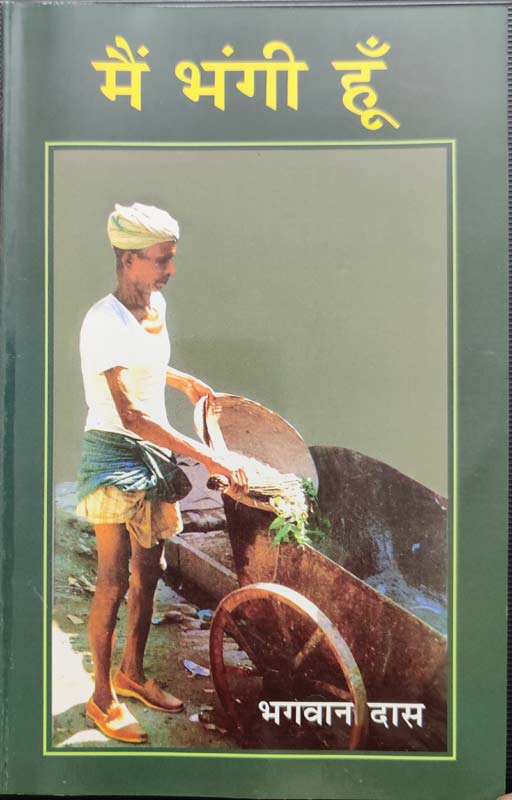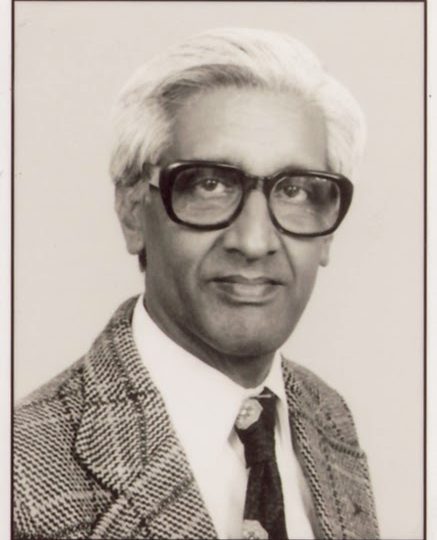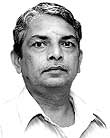Dhamma Darshan Nigam
This article is an attempt, one, to bring Advocate Bhagwan Das’s already popular book ‘Main Bhangi Hun’ to the light one more time; two, to look at a few of the present problems of sanitation workers and contextualize them with what Das has argued in this book as contemporary; and three, to highlight the importance of Das for sanitation workers in achieving total liberation from the caste based and sanitation related servitudes. This book suggests that having an historical point of view about their life and work is very crucial for sanitation workers to remain historically and politically relevant and to live a dignified life.
A small incident that illustrates the scholarship of Advocate Bhagwan Das occurred in 1956, when he was about 29 years old and used to work with Dr. Babasaheb Ambedkar as a Research Assistant. One evening, around 5 o’clock, he was sitting, with Babasaheb, in the verandah, with Charles Darwin’s book ‘The Origin of Species’ in his hands. Taking that book from Bhagwan Das, Babasaheb says “I do not agree with Darwin who gave and propagated the theory of ‘Survival of the fittest’”.
Bhagwan Das humbly asks for his permission to say something and then says, “Darwin did not formulate the theory of survival of the fittest. He only wrote that species which fail to make adjustments with the changing environment become extinct”. Bhagwan Das narrates further in his book that Babasaheb remained silent on hearing this and then asked, “You have done M.A. in Anthropology?” Bhagwan Das replies, “No, I have not been able to go to any college or university till now”.
Bhagwan Das further narrates that after a while Babasaheb again asks, “You have done M.A. Anthropology?” Bhagwan Das says “Sir I could not study beyond matriculation. I had a lot of household responsibilities. There was not even any college in Shimla before India became independent. Babasaheb says, “It doesn’t matter. I have got miles of degrees; what matters is the knowledge one has and knows how to use it”.
The questions that arise from this small incident are that whether the general population of Bhangis[i], the Bhangi intellectuals and other ‘sanitation labour castes’[ii] are able to understand the changing social, cultural and political environment around them or not? If they are comprehending the changing environment, then are they ready to change themselves or their surroundings with time or not? And if they are not able to understand the changing environment and are not changing according to them, then they may or may not become extinct with time, but their glorious history, which Babasaheb and Bhagwan Das have talked about in their writings, will surely go extinct or would be given very different shades over time through which it would be difficult to see their history clearly.
To save their history, people need to be socially, politically, culturally and historically aware. They should know how to read history. They should know how to read politics, culture, and society. They should know that history is also read and written politically, and politics is also read and written historically, and both of these processes and/or writings are not unaffected by the local culture that people live in, and the culture that a nation celebrates as the national culture. People should know and understand that history, politics, culture, and society are always interconnected. Babasaheb could write Annihilation of Caste and Bhagwan Das could write Main Bhangi Hun because they knew that all these streams of life are interconnected. To save their history people need to be aware of and oppose the continuous attacks on it. People should continuously oppose the appropriation of their history. And history is not appropriated, diminished, and eroded just by altering it in new writings, but also by attacking those people in the present who narrate and uphold their authentic history.
The way sanitation labour caste members are dying due to sewers and septic tanks cleaning, and the continuous failure of different governments to save them for a long time. It looks like this is going to continue as it is. If these people continue to clean sewers and septic tanks then they will continue to die like this, and if they continue to die like this then in the next few decades the number of young males in the community will start decreasing considerably. As a result, there will be fewer newborns, which will affect their population as a community, moderately but surely. It may also be seen as a very systematic, slow and subtle way of ethnic cleansing. That is what India’s caste society wants for the sanitation labour castes–to make the untouchable ultimately unseeable–to get rid of them. That is why the political and civil society seems unwilling to find a solution to stop sewer deaths – to maintain the status-quo and the caste hegemony, all-pervasive and intact.
But, also at the same time, they cannot make sure that their hegemony would last long if there are no people left to hegemonize. That is why they would also not let all sanitation workers die in sewers and septic tanks, but only a few can die on a regular basis. The community at the peak of the caste society will remain there till the time there are communities at the very bottom. They need some castes at lower levels to call themselves higher. In such a situation it becomes very important for sanitation labour castes to start thinking of freeing themselves from the caste system and think more of themselves. This is not separate from the discussion about Advocate Bhagwan Das, but both the issues are part of the complexity of the caste system, and the intertwined interconnectedness of the many aspects of the life of the sanitation labour castes, such that if one starts talking about one issue the other one will automatically come into the picture. Here I come back to the point from where I took a detour.
Jules Michelet, a French historian, warns that “he who would confine his thoughts to present time will not understand present reality”. And trying to understand the present reality from the perspective of only the present time can engender what Nigerian writer Chimamanda Ngozi Adichie called the “the danger of a single story”. She notes that “The single story creates stereotypes. And the problem with stereotypes is not that they are untrue, but that they are incomplete. They make one story become the only story….The consequence of the single story is this: It robs people of dignity. It makes our recognition of our equal humanity difficult.…Stories matter. Many stories matter. Stories have been used to dispossess and to malign. But stories can also be used to empower, and to humanize. Stories can break the dignity of a people. But stories can also repair that broken dignity.” A similar thought can be found in the words of Fredric Jameson, author of the book The Political Unconscious, who says,“ Always Historicize”. This means that people should always make a connection of present reality with history to understand a story in its entirety. People should always compare the present with history, and always try to understand things from the point of view of history. And on history, Babasaheb Ambedkar also said that “those who do not know their history can never make history”.

And Advocate Bhagwan Das is one such person who through his book Main Bhangi Hun, has not only written the history of the Bhangi community, but has also written the history of the future of the Bhangi community. Now the point comes, whether this book reaches all the sanitation labour castes or not, and if it reaches them then whether everyone would understand it or not, and if they understand it, then whether they would implement the recommendations in their lives or not.
This book of Bhagwan Das is not an ordinary book, but a description of the social, political, psychological, cultural, and religious history of the Bhangi community, which is the result of his deep study and lifelong research. He says that “this is not my autobiography”, but “the story of all the untouchable castes”. He notes that “the names, professions, occupations of the untouchable castes may be different, but there is no difference in the attitude and hatred of the so called upper castes towards untouchables. The exploitation, poverty, weaknesses arising out of poverty, atrocities on them have remained the same.” Thereby, this book is not only the history of the future of the Bhangi community, but of all untouchable castes. If Annihilation of the Caste is the goal then Main Bhangi Hun is the blueprint to achieve that goal.
In today’s time, it is no more a hidden fact that the social, political, cultural, and religious structure of this country has forced the sanitation labour castes to lead a hellish life. If our educated young boys and girls go to some company, a shopping complex or a hotel to find jobs, then after knowing their caste, they are offered only cleaning and housekeeping jobs. This is the naked reality of many small towns in India. In different municipal corporations, a rule has been made that after the retirement of a sanitation worker from the municipal corporation, only his/her children will be kept on the job. As if the cleaning profession is made for our castes only.
For freedom from this cleaning profession in present times and also to ensure it in the future, it is necessary to improve the present conditions, but that would be just the first step. And Bhangi intellectuals have to make sure that this first step does not remain the only step, which unfortunately seems to be happening. Most of the people working on the issues of sanitation workers remain embroiled in the issues of unsafe working and living conditions, irregular and minimum wages, health conditions, and exploitation by contractors. After improving these working and living conditions of sanitation labour castes, they must also look at the root cause behind these problems which always remain almost unchallenged and is the reality of the problem.
The reality of the problem of sanitation workers is the problem of caste. The reality of the problem is that almost the entire country has accepted that a particular group of castes are there only to clean their shit. The reality of the problem is that in such a society, sanitation work always remains very essential, but the sanitation workers remain completely non-essential. The reality of the problem is as contemporary as it is historically political and cultural. And the solution of this problem lies in this book by Advocate Bhagwan Das, which must be read and understood very carefully and very honestly by those aiming to reform this society.
Bhagwan Das summarizes his message saying that “Yesterday’s ruler and master is today’s slave, but today’s exploited, oppressed and enslaved can again become the ruler and governor of the country tomorrow. That is the message of this book.” From this statement of Bhagwan Das, the question that arises which the sanitation labour castes should try to answer is that, what were the beliefs and what was the culture of their community when they were rulers in the past? Every ruling class has a religion too, so which religion did this ruling community of the past follow? How did these rulers of the past become enslaved? Answers to all these questions lie in this book by Bhagwan Das, which demands to be read with sincerely, open-mindedly, and without any bias.
Raising a much deeper and more complex problem for the Bhangi community to address, Bhagwan Das writes:
‘Hindus started preaching about Hindu religion among the untouchables in the last decades of the nineteenth century in order to fool the untouchables for the fear that the population of Hindus would be less than that of the Muslims in the Census. Coming under the influence of this propaganda, the people of Chuhra caste of Punjab started writing the name of their caste as Valmiki. The sad thing is that not only did it stop their mental, political, economic, and social progress, but it also caused a greater loss that the writers of this caste, instead of thinking and writing about their other problems like poverty, backwardness, superstition, social evils, injustice, and atrocities on them, went after Valmiki, who probably has no direct connection with the Bhangi caste.’
Bhagwan Das is saying that Valmiki had no connection with Bhangi or Chuhra caste, and to increase the number of Hindus, as part of the Hindu propaganda, Valmiki was propagated among the Bhangi caste. Here, the question raised earlier becomes pertinent: what was the religion of the Bhangi caste before this propaganda by Hindus? Bhangis were under the influence of which religion before Hinduism? Was the purpose of this propaganda solely to increase the population of Hindus in the Census, or were there some other motives as well? The answers to all these questions are there in this book by Bhagwan Das.
To make it easy to answer these questions, Advocate Bhagwan Das has presented this book to us in the form of a story. And this story is a long story. Bhagwan Das writes, “The book was not divided into parts. It is written like a story in a sequence. This will put some people off, but it was done to keep this story like a story being told by an ordinary person.”
Bhagwan Das, in this book, has written about the influence of Buddhism, Brahminism, Islam, Britishers, and Gandhism on the community, on how Bhangi community got its different names (e.g. Dom, Domar, Chuhra, Halalkhor etc.); how Lalbeg became Balmiki, and how simple and innocent people were tricked and left to live on the mercy of their exploiters. This long history also shows that the socio-cultural-political history of the community is not just a single story which can be written or explained in a linear narrative, rather, many factors have contributed and counteracted in it, positive as well as negative. And there are still misconceptions in the community about which factors had a positive influence and which factors impacted them negatively.
In spreading these misconceptions, all the different governments of this country have played key roles. These governments, in order to remain in power, projected positive factors as negatives and negative factors as positives, which also kept the community unaware of their true history.
This book is an important book to clear these misconceptions. This book is already a very popular book among the enlightened members of the community. This book is a guide and a hope for sanitation labour castes. The old and new readers of this book must always be eager to learn something new with every reading, and must strive and commit to the cause of sanitation workers.
The ruling castes of the past can become rulers once more in the future, if they read the ‘true Ambedkarite’ Advocate Bhagwan Das and follow his path. This book is both history and future of the Bhangi Community.
Images courtesy: Google.
~
Notes
[i]I have used the word Bhangi in the cultural context, i.e. the name of a community, like Advocate Bhagwan Das has himself done in his book ‘Main Bhangi Hun’, Kanpur based writer-activist Dev Kumar in his book ‘Haan Haan Haan Main Bhangi Hun’, and Prof. Shyamlal in his book ‘Untold Story of a Bhangi Vice-Chancellor’.
[ii] The phrase ‘sanitation labour castes’ is taken from Joel Lee’s book Deceptive Majority: Dalits, Hinduism and Underground Religion. It is about all the castes which are forced into sanitation labour and manual scavenging hereditarily.
~~~
Dhamma Darshan Nigam works with the Safai Karmachari Andolan and is an activist and writer.










